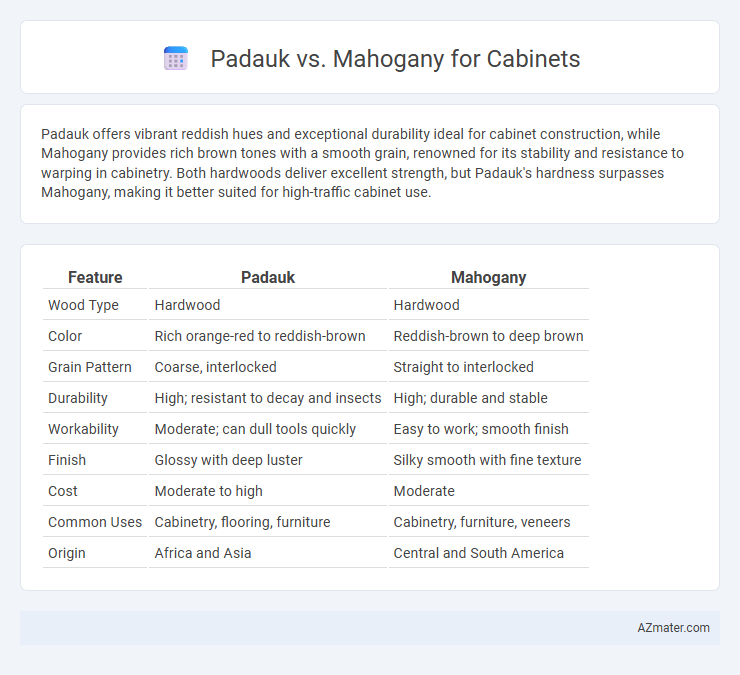Padauk offers vibrant reddish hues and exceptional durability ideal for cabinet construction, while Mahogany provides rich brown tones with a smooth grain, renowned for its stability and resistance to warping in cabinetry. Both hardwoods deliver excellent strength, but Padauk's hardness surpasses Mahogany, making it better suited for high-traffic cabinet use.
Table of Comparison
| Feature | Padauk | Mahogany |
|---|---|---|
| Wood Type | Hardwood | Hardwood |
| Color | Rich orange-red to reddish-brown | Reddish-brown to deep brown |
| Grain Pattern | Coarse, interlocked | Straight to interlocked |
| Durability | High; resistant to decay and insects | High; durable and stable |
| Workability | Moderate; can dull tools quickly | Easy to work; smooth finish |
| Finish | Glossy with deep luster | Silky smooth with fine texture |
| Cost | Moderate to high | Moderate |
| Common Uses | Cabinetry, flooring, furniture | Cabinetry, furniture, veneers |
| Origin | Africa and Asia | Central and South America |
Introduction to Padauk and Mahogany
Padauk, known for its vibrant reddish-orange hue and durable hardwood properties, offers exceptional resistance to decay and insect damage, making it ideal for cabinetry requiring both aesthetics and longevity. Mahogany, prized for its rich reddish-brown color and fine grain, provides superior workability and stability, often favored in high-end furniture and cabinetry for its elegant appearance and resistance to warping. Both woods serve as premium choices in cabinetry, balancing beauty with strength, though Padauk stands out for its vivid color, while Mahogany excels in classic sophistication and ease of finishing.
Origin and Botanical Differences
Padauk wood, primarily sourced from tropical regions in Africa and Southeast Asia, belongs to the Pterocarpus genus and is known for its vibrant reddish-orange hue and dense grain structure. Mahogany, originating mainly from Central and South America, especially Belize, Honduras, and Mexico, comes from the Swietenia genus and features a smoother texture with a rich, warm brown color. Botanically, Padauk trees produce more porous hardwood with interlocked grain patterns, whereas Mahogany trees yield a tight-grained, moderately coarse wood favored for fine cabinetry and veneers.
Color and Grain Comparison
Padauk offers a vibrant reddish-orange hue that deepens to a rich, warm red over time, creating a striking focal point in cabinetry. Mahogany presents a more subdued, classic reddish-brown color with fine, straight grain patterns that exude elegance and traditional charm. The bold, coarse grain of Padauk contrasts sharply with Mahogany's smoother, more uniform texture, making color and grain key considerations in choosing between these woods for cabinets.
Durability and Hardness
Padauk wood exhibits excellent durability with a Janka hardness rating of approximately 1,730, making it highly resistant to wear and impact for cabinet construction. Mahogany, known for its moderate hardness around 900 to 1,100 Janka, offers good durability but is comparatively softer and more prone to dents and scratches. For cabinets requiring superior strength and long-lasting performance, Padauk is generally a more resilient choice than Mahogany.
Workability and Machining
Padauk offers excellent workability with a relatively stable grain and good dimensional stability, making it easier to machine for intricate cabinet designs. Mahogany is prized for its smooth texture and consistent grain, which allows clean cuts and detailed carvings with minimal tool wear. Both woods handle sanding and finishing well, but Padauk's density can cause faster tool dulling compared to the softer, more forgiving Mahogany.
Resistance to Pests and Decay
Padauk exhibits excellent resistance to pests and decay due to its natural oils and dense grain, making it highly durable for cabinetry in humid or insect-prone environments. Mahogany also offers strong resistance, particularly genuine Honduran mahogany, which contains natural compounds that deter termites and fungal attacks while providing stability against rot. For cabinets exposed to moisture and pests, both woods are reliable, but Padauk's superior hardness and oil content give it an edge in longevity and structural integrity.
Cost and Availability
Padauk wood is generally more affordable and widely available in North America and Asia compared to mahogany, which is often pricier due to limited supply and slower growth rates. Mahogany's premium cost reflects its reputation for durability and fine grain, making it a popular choice for high-end cabinetry despite restricted availability. Availability of padauk can fluctuate seasonally, but its lower price point and vibrant reddish-orange hue make it a popular budget-friendly alternative to mahogany in cabinetry projects.
Environmental and Sustainability Considerations
Padauk, sourced primarily from sustainable African and Southeast Asian forests with certified harvesting practices, offers a more eco-friendly option compared to many mahogany varieties, some of which come from regions facing deforestation and illegal logging issues. Mahogany, particularly bigleaf and Honduran types, often have slower growth rates and are listed under CITES Appendix II, reflecting concerns over habitat loss and sustainability. Choosing Padauk for cabinets supports renewable forestry and reduces environmental impact due to faster regrowth and more widespread sustainable management initiatives.
Best Uses in Cabinetry
Padauk offers vibrant reddish-orange hues ideal for accent pieces or statement cabinets, enhancing modern and eclectic kitchen designs. Mahogany's rich, deep brown tones and durability make it perfect for classic, high-end cabinetry requiring strength and resistance to wear. Both woods provide excellent stability, but Mahogany's fine grain is favored for intricate, detailed cabinetwork, while Padauk's bold color suits bold, contemporary styles.
Conclusion: Which Wood Suits Your Cabinets?
Padauk offers vibrant reddish-orange hues and exceptional durability, making it ideal for striking, long-lasting cabinets that resist wear and insect damage. Mahogany provides a classic, rich brown tone with fine grain and excellent workability, perfect for elegant, timeless cabinetry with smooth finishes. Choose Padauk for bold aesthetics and robustness, while Mahogany suits those seeking traditional beauty and refined craftsmanship in cabinets.

Infographic: Padauk vs Mahogany for Cabinet
 azmater.com
azmater.com